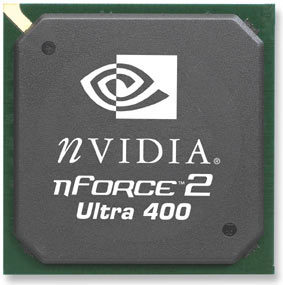Athlon Hit Parade: 10 mobos with the nForce2 Ultra400
NVIDIA nForce2 400 Ultra
The nForce2 chipset has been on the market for just under a year. The version under scrutiny today, which boasts the suffix "Ultra 400," is a little more powerful than before and, in addition, supports all FSB clock rates, starting with 100 MHz for the Duron right up to 200 MHz for the Barton core. The FSB operates in the dual data rate mode, which effectively doubles the transfer rate and therefore explains its name - "Ultra 400."
In technical terms, the nForce2 is almost right at the head of the class. While it doesn't yet feature an integrated serial ATA controller, it does come with a FireWire interface, which means that just one codec can be used instead of a fully-fledged controller. Another special feature of the nForce2 is the inclusion of two Ethernet interfaces. They may only be intended for 100 Mbit/s and only enable Gigabit Ethernet at the cost of bandwidth via the PCI bus, but every conceivable combination is possible, meaning that PCs can be connected to LAN and WAN at the same time. The fact that it supports Dolby Digital 5.1 via the Southbridge MCP-T is also a ground-breaking development.
Fan Control: Never Use It Blindly!
One of the annoying characteristics of fast processors is their acoustic obtrusiveness. Fast hard drives and fans for the chipsets, the graphics card, the mains adaptor and the processor all up the noise level.
Two of the motherboards tested (e.g. AOpen, Asus) offer the factory-installed option of curtailing the noise level by reducing the fan speed. To this end it is possible to select a corresponding operating mode in either BIOS or Windows.
Another option is to interpose a resistor that controls the fan speed either manually or automatically, depending on the temperature. Both types are available in shops for as little as $10 and can reduce the noise level significantly.
However, care should be exercised if you are using a combination of both approaches - and you might be doing so unintentionally. Those who own a motherboard with intelligent fan control should not use yet another fan that can be switched down, as the outcome is not always predictable.
Get Tom's Hardware's best news and in-depth reviews, straight to your inbox.

Patrick Schmid was the editor-in-chief for Tom's Hardware from 2005 to 2006. He wrote numerous articles on a wide range of hardware topics, including storage, CPUs, and system builds.
